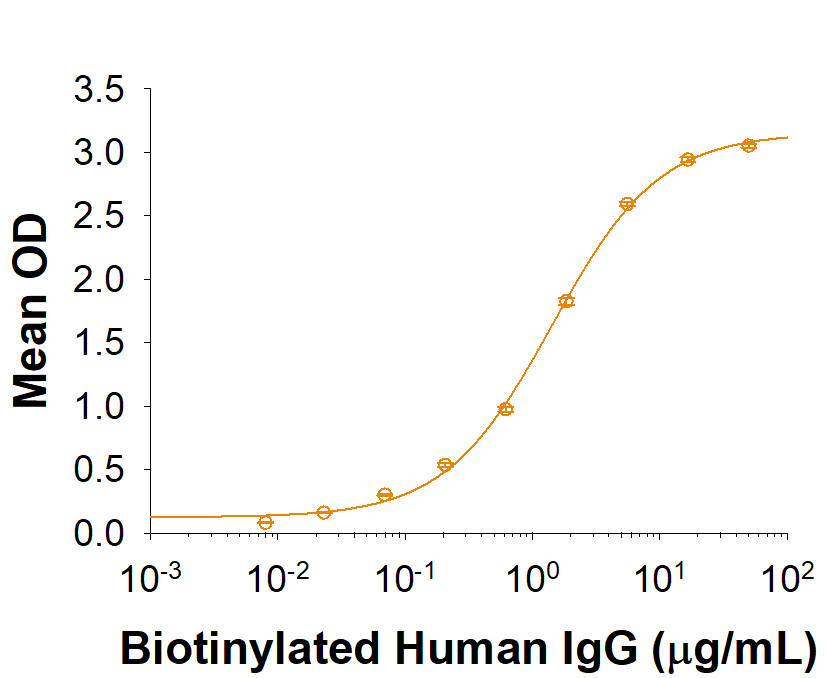Recombinant Human Fc gamma RIIIA/CD16a (V176F) Protein, CF
Recombinant Human Fc gamma RIIIA/CD16a (V176F) Protein, CF Summary
Product Specifications
Analysis
Product Datasheets
Carrier Free
CF stands for Carrier Free (CF). We typically add Bovine Serum Albumin (BSA) as a carrier protein to our recombinant proteins. Adding a carrier protein enhances protein stability, increases shelf-life, and allows the recombinant protein to be stored at a more dilute concentration. The carrier free version does not contain BSA.
In general, we advise purchasing the recombinant protein with BSA for use in cell or tissue culture, or as an ELISA standard. In contrast, the carrier free protein is recommended for applications, in which the presence of BSA could interfere.
8894-FC
| Formulation | Lyophilized from a 0.2 μm filtered solution in sterile PBS. |
| Reconstitution | Reconstitute at 100 μg/mL in PBS. |
| Shipping | The product is shipped at ambient temperature. Upon receipt, store it immediately at the temperature recommended below. |
| Stability & Storage: | Use a manual defrost freezer and avoid repeated freeze-thaw cycles.
|
Scientific Data
 View Larger
View Larger
When Recombinant Human Fc gamma RIIIa/CD16a (V176F) was immobilize on a Ms x PolyHis coated plate, it binds biotinylated Human IgG with an ED50 of 0.5-2.5 μg/mL.
Reconstitution Calculator
Background: Fc gamma RIIIA/CD16a
Fc gamma RIIIA/CD16a is a low/intermediate affinity receptor for polyvalent immune-complexed IgG. It is involved in phagocytosis, secretion of enzymes and inflammatory mediators, antibody-dependent cytotoxicity, and clearance of immune complexes (1-3). In humans, it is expressed as a 50-70 kDa transmembrane activating receptor on NK cells, T cells, monocytes, and macrophages (2). It is closely related to the GPI-linked Fc gamma RIIIB which is expressed on human neutrophils and eosinophils (1, 3). These two proteins share 97% amino acid (aa) identity within their extracellular domains (ECD) (4). The ECD of Fc gamma RIIIA also shares 63%, 61%, 65%, 59%, and 58% aa identity with mouse Fc gamma RIV, rat Fc gamma RIIIA, feline CD16, bovine CD16, and porcine Fc gamma RIIIB, respectively. Mature human Fc gamma RIIIA consists of a 192 aa ECD with two C2-type Ig-like domains, a 21 aa transmembrane segment, and a 25 aa cytoplasmic domain. In humans, a single nucleotide polymorphism (T230A) creates high binding (176V) and low binding (176F) forms that may influence susceptibility to autoimmune diseases or response to therapeutic IgG antibodies (5, 6). Fc gamma RIIIA surface expression requires interaction with an accessory chain, either the common gamma -chain or CD3 zeta (7, 8). Glycosylation patterns, electrophoretic mobility, and binding affinity appear to differ between NK cell and monocyte Fc gamma RIIIA (9). Shed forms of both Fc gamma RIIIA and Fc gamma RIIIB can be generated by proteolytic cleavage and retain binding activity (10-13). Shedding from monocytes and macrophages can be triggered by cell activation or phagocytosis (13). Soluble Fc gamma RIII circulates in normal plasma and is elevated in rheumatoid arthritis and in coronary artery diseases (11, 12).
- Nagelkerke, S.Q. and T.W. Kuijpers (2015) Front. Immunol. 5:674.
- Nimmerjahn, F. and J.V. Ravetch (2006) Immunity 24:19.
- Ravetch, J.V. and B. Perussia (1989) J. Exp. Med. 170:481.
- Scallon, B.J. et al. (1989) Proc. Natl. Acad. Sci. USA 86:5079.
- Wu, J. et al. (1997) J. Clin. Invest. 100:1059.
- Dall’Ozzo, S. et al. (2004) Cancer Res. 64:4664.
- Kim, M.-K. et al. (2003) Blood 101:4479.
- Lanier, L.L. et al. (1989) Nature 342:803.
- Edberg, J.C. and R.P. Kimberley (1997) J. Immunol. 159:3849.
- Li, P. et al. (2007) J. Biol. Chem. 282:6210.
- Masuda, M. et al. (2003) J. Rheumatol. 30:1911.
- Masuda, M. et al. (2006) Atherosclerosis 188:377.
- Webster, N.L. et al. (2006) J. Leukoc. Biol. 79:294.
Citations for Recombinant Human Fc gamma RIIIA/CD16a (V176F) Protein, CF
R&D Systems personnel manually curate a database that contains references using R&D Systems products. The data collected includes not only links to publications in PubMed, but also provides information about sample types, species, and experimental conditions.
2
Citations: Showing 1 - 2
Filter your results:
Filter by:
-
Discovery of a novel Igbeta and FcgammaRIIB cross-linking antibody, ASP2713, and its potential application in the treatment of systemic lupus erythematosus
Authors: Y Kitanaga, D Yamajuku, S Kubo, K Nakamura, M Maeda, M Seki, Y Kaneko, F Kinugasa, T Morokata, Y Kondo, H Yoshinari, S Nakayamada, T Sumida, Y Tanaka
International immunopharmacology, 2021-11-12;101(0):108343.
Species: Human
Sample Types: Recombinant Protein
Applications: ELISA Capture -
Anti-CD20 Antibody with Multimerized Fc Domains: A Novel Strategy To Deplete B Cells and Augment Treatment of Autoimmune Disease.
Authors: Zhang X, Olsen H, Chen S, So E, Zhou H, Burch E, Merigeon E, Block D, Strome S
J Immunol, 2015-12-22;196(3):1165-76.
Applications: Surface Plasmon Resonance
FAQs
-
Is Recombinant Human Fc gamma RIIIA/CD16a (V176F) Protein, CF (Catalog # 8894-FC) the low binding or high binding form?
Catalog # 8894-FC has Phenylalanine (F) at amino acid position 176, making it the low binding form. We also offer the high binding form, with 176V, as catalog # 4325-FC.
Reviews for Recombinant Human Fc gamma RIIIA/CD16a (V176F) Protein, CF
There are currently no reviews for this product. Be the first to review Recombinant Human Fc gamma RIIIA/CD16a (V176F) Protein, CF and earn rewards!
Have you used Recombinant Human Fc gamma RIIIA/CD16a (V176F) Protein, CF?
Submit a review and receive an Amazon gift card.
$25/€18/£15/$25CAN/¥75 Yuan/¥2500 Yen for a review with an image
$10/€7/£6/$10 CAD/¥70 Yuan/¥1110 Yen for a review without an image
